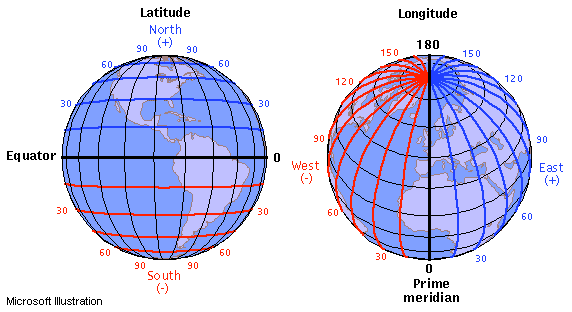

 |
 |
 |
 |
 |
The changing photoperiods that you've tracked have provided some clues about the LATITUDE of the Mystery Classes. But that photoperiod information doesn't help you much when you try to determine the LONGITUDE of the Mystery Classes.
However, there are certain clues that can help you estimate Longitude when used in connection with the SPRING EQUINOX. These are called The Longitude Clues.
Only on the Equinox (spring or fall) do these clues work. As your graph will show, on the Equinox everyone on earth has about the same amount of daylight. At all other times of year, either the Northern Hemisphere or Southern Hemisphere has more daylight due to the tilt of the Earth's axis. But on the Equinox, neither of the poles of the Earth is tilted toward or away from the sun. Because of this fact, using the Longitude Clues, you will be able to estimate approximate LONGITUDE by knowing the time of sunrise at the Mystery Class on the Equinox when you are given that sunrise time in Greenwich Mean Time (GMT). Whew, sound confusing? Hang in there, because this is quite amazing!
How Time and Longitude are Related
In order to use the GMT/Longitude Clues to help you ESTIMATE the approximate longitude of a Mystery Class, you must first understand a little background about the relationship between time and longitude. A sphere such as the Earth is divided by longitude lines into 360 degrees. If you hold your globe with the North Pole on top, you can see that the vertical longitude "meridians" add up to 360 degrees.
Think
about this: In order for sunrise to occur everyplace on earth each
day, the earth must spin or rotate 360 degrees on its axis every 24
hours. This is also explained in the lesson Does
The Sun Really "Rise" and "Set"
|
Using
the following equation, you can figure out how many degrees
the earth turns in each hour: Using a division equation again, you can also figure out how many minutes it takes for the earth to spin 1 degree: 60 minutes divided by 15 degrees = 4 minutes per degree. |
Why Greenwich Mean Time is Important
Greenwich Mean Time (GMT) is an international time-keeping standard based on the local time at the 0 longitude point--called the Prime Meridian--in Greenwich, England. Longitude values to the east of the Prime Meridian are designated as 0 to 180 degrees East longitude; while those values to the west of the Prime Meridian are designated as negative numbers of 0 to -180 degrees West longitude. Using GMT, you have an important clue to the approximate longitude location of your Mystery Classrooms. Read on!
| |
